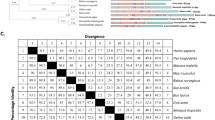Play all audios:

ABSTRACT Our study of transforming genes led us to the identification of a new protein module, the WW domain, that is found in a wide range of structural, regulatory and signaling proteins.
The WW domain is functionally similar to the SH3 module, in that it binds polyproline containing ligands. However, its structure is distinct. Unexpectedly, the WW domain-polyproline ligand
connection was recently implicated in several human genetic disorders including the Mendelian form of hypertension known as Liddle's syndrome, and indirectly in muscular dystrophy,
Alzheimer's disease and also in limb and kidney formation. Since both the WW domain and the core motif of its ligand are relatively short (40 and 5 amino acid residues), one could
suggest that human diseases that involve mutations of these sequences could be treated successfully, not only by gene therapy approaches, but also by low molecular weight compounds. The
rigid molecular shapes represented by the polyproline cores of the WW domain ligands could serve as guides for rational drug design. SIMILAR CONTENT BEING VIEWED BY OTHERS WWP1 E3 LIGASE AT
THE CROSSROADS OF HEALTH AND DISEASE Article Open access 21 December 2023 STRUCTURAL, MOLECULAR, AND FUNCTIONAL INSIGHTS INTO SCHLAFEN PROTEINS Article Open access 29 June 2022 THE SCRIBBLE
FAMILY IN CANCER: TWENTIETH ANNIVERSARY Article 30 September 2020 ARTICLE PDF AUTHOR INFORMATION AUTHORS AND AFFILIATIONS * Department of Biochemistry, Mount Sinai School of Medicine, One
Gustave Levy Place, New York, NY, 10029, U.S.A. Marius Sudol Authors * Marius Sudol View author publications You can also search for this author inPubMed Google Scholar RIGHTS AND
PERMISSIONS This is an Open Access article distributed under the terms of the Creative Commons Attribution Non-Commercial License (http://creativecommons.org/licenses/by-nc/3.0/) which
permits unrestricted non-commercial use, distribution, and reproduction in any medium, provided the original work is properly cited. Reprints and permissions ABOUT THIS ARTICLE CITE THIS
ARTICLE Sudol, M. The WW domain binds polyprolines and is involved in human diseases. _Exp Mol Med_ 28, 65–69 (1996). https://doi.org/10.1038/emm.1996.10 Download citation * Published: 01
June 1996 * Issue Date: 01 June 1996 * DOI: https://doi.org/10.1038/emm.1996.10 SHARE THIS ARTICLE Anyone you share the following link with will be able to read this content: Get shareable
link Sorry, a shareable link is not currently available for this article. Copy to clipboard Provided by the Springer Nature SharedIt content-sharing initiative
